Improvement of Lithium Storage Performance of Silica Anode by Using Ketjen Black as Functional Conductive Agent
Abstract
:1. Introduction
2. Materials and Methods
2.1. Synthesis
2.2. Materials Characterization
2.3. Electrochemical Measurements
3. Results and Discussion
4. Conclusions
Author Contributions
Funding
Institutional Review Board Statement
Informed Consent Statement
Data Availability Statement
Acknowledgments
Conflicts of Interest
References
- Zhang, Z.; Wang, F.; An, Q.; Li, W.; Wu, P. Synthesis of graphene@Fe3O4@C core–shell nanosheets for high-performance lithium ion batteries. J. Mater. Chem. A 2015, 3, 7036–7043. [Google Scholar] [CrossRef]
- Hou, G.; Cheng, B.; Yang, Y.; Du, Y.; Zhang, Y.; Li, B.; He, J.; Zhou, Y.; Yi, D.; Zhao, N.; et al. Multiscale Buffering Engineering in Silicon–Carbon Anode for Ultrastable Li-Ion Storage. ACS Nano 2019, 13, 10179–10190. [Google Scholar] [CrossRef]
- Choi, J.W.; Aurbach, D. Promise and reality of post-lithium-ion batteries with high energy densities. Nat. Rev. Mater. 2016, 1, 16013. [Google Scholar] [CrossRef]
- Tu, J.; Yuan, Y.; Zhan, P.; Jiao, H.; Wang, X.; Zhu, H.; Jiao, S. Straightforward Approach toward SiO2 Nanospheres and Their Superior Lithium Storage Performance. J. Phys. Chem. C 2014, 118, 7357–7362. [Google Scholar] [CrossRef]
- Song, T.; Xia, J.; Lee, J.-H.; Lee, D.H.; Kwon, M.-S.; Choi, J.-M.; Wu, J.; Doo, S.K.; Chang, H.; Park, W.I.; et al. Arrays of Sealed Silicon Nanotubes As Anodes for Lithium Ion Batteries. Nano Lett. 2010, 10, 1710–1716. [Google Scholar] [CrossRef] [PubMed]
- Li, J.Y.; Li, G.; Zhang, J.; Yin, Y.X.; Yue, F.S.; Xu, Q.; Guo, Y.G. Rational Design of Robust Si/C Microspheres for High-Tap-Density Anode Materials. ACS Appl. Mater. Interfaces 2019, 11, 4057–4064. [Google Scholar] [CrossRef]
- Xu, Q.; Li, J.Y.; Sun, J.K.; Yin, Y.X.; Wan, L.J.; Guo, Y.G. Watermelon-Inspired Si/C Microspheres with Hierarchical Buffer Structures for Densely Compacted Lithium-Ion Battery Anodes. Adv. Energy Mater. 2017, 7, 1601481. [Google Scholar] [CrossRef]
- Ma, T.; Xu, H.; Yu, X.; Li, H.; Zhang, W.; Cheng, X.; Zhu, W.; Qiu, X. Lithiation Behavior of Coaxial Hollow Nanocables of Carbon–Silicon Composite. ACS Nano 2019, 13, 2274–2280. [Google Scholar] [CrossRef]
- Zhang, C.; Gu, L.; Kaskhedikar, N.; Cui, G.; Maier, J. Preparation of Silicon@Silicon Oxide Core–Shell Nanowires from a Silica Precursor toward a High Energy Density Li-Ion Battery Anode. ACS Appl. Mater. Interfaces 2013, 5, 12340–12345. [Google Scholar] [CrossRef]
- Zhai, W.; Ai, Q.; Chen, L.; Wei, S.; Li, D.; Zhang, L.; Si, P.; Feng, J.; Ci, L. Walnut-inspired microsized porous silicon/graphene core–shell composites for high-performance lithium-ion battery anodes. Nano Res. 2017, 10, 4274–4283. [Google Scholar] [CrossRef]
- Lu, B.; Ma, B.; Deng, X.; Li, W.; Wu, Z.; Shu, H.; Wang, X. Cornlike Ordered Mesoporous Silicon Particles Modified by Nitrogen-Doped Carbon Layer for the Application of Li-Ion Battery. ACS Appl. Mater. Interfaces 2017, 9, 32829–32839. [Google Scholar] [CrossRef] [PubMed]
- Chen, X.; Li, X.; Ding, F.; Xu, W.; Xiao, J.; Cao, Y.; Meduri, P.; Liu, J.; Graff, G.L.; Zhang, J.-G. Conductive Rigid Skeleton Supported Silicon as High-Performance Li-Ion Battery Anodes. Nano Lett. 2012, 12, 4124–4130. [Google Scholar] [CrossRef]
- Gowda, S.R.; Pushparaj, V.; Herle, S.; Girishkumar, G.; Gordon, J.G.; Gullapalli, H.; Zhao, X.; Ajayan, P.M.; Reddy, A.L.M. Three-dimensionally engineered porous silicon electrodes for Li ion batteries. Nano Lett. 2012, 12, 6060–6065. [Google Scholar] [CrossRef] [PubMed]
- Liu, Z.; Yu, Q.; Zhao, Y.; He, R.; Xu, M.; Feng, S.; Li, S.; Zhou, L.; Mai, L. Silicon oxides: A promising family of anode materials for lithium-ion batteries. Chem. Soc. Rev. 2018, 48, 285–309. [Google Scholar] [CrossRef]
- Liang, C.; Zhou, L.; Zhou, C.; Huang, H.; Liang, S.; Xia, Y.; Gan, Y.; Tao, X.; Zhang, J.; Zhang, W. Submicron silica as high−capacity lithium storage material with superior cycling performance. Mater. Res. Bull. 2017, 96, 347–353. [Google Scholar] [CrossRef]
- Zhang, Y.; Li, Y.; Wang, Z.; Zhao, K. Lithiation of SiO2 in Li-Ion Batteries: In Situ Transmission Electron Microscopy Experiments and Theoretical Studies. Nano Lett. 2014, 14, 7161–7170. [Google Scholar] [CrossRef]
- Chang, W.S.; Park, C.M.; Kim, J.H.; Kim, Y.U.; Jeong, G.; Sohn, H.J. Quartz (SiO2): A new energy storage anode material for Li-ion batteries. Energy Environ. Sci. 2012, 5, 6895–6899. [Google Scholar] [CrossRef]
- Ma, X.; Wei, Z.; Han, H.; Wang, X.; Cui, K.; Yang, L. Tunable construction of multi-shell hollow SiO2 microspheres with hierarchically porous structure as high-performance anodes for lithium-ion batteries. Chem. Eng. J. 2017, 323, 252–259. [Google Scholar] [CrossRef]
- Yuan, Z.; Zhao, N.; Shi, C.; Liu, E.; He, C.; He, F. Synthesis of SiO2/3D porous carbon composite as anode material with enhanced lithium storage performance. Chem. Phys. Lett. 2016, 651, 19–23. [Google Scholar] [CrossRef]
- Li, H.H.; Wu, X.L.; Sun, H.Z.; Wang, K.; Fan, C.Y.; Zhang, L.L.; Yang, F.M.; Zhang, J.P. Dual-Porosity SiO2/C Nanocomposite with Enhanced Lithium Storage Performance. J. Phys. Chem. C 2015, 119, 3495–3501. [Google Scholar] [CrossRef]
- Xiao, T.; Zhang, W.; Xu, T.; Wu, J.; Wei, M. Hollow SiO2 microspheres coated with nitrogen doped carbon layer as an anode for high performance lithium-ion batteries. Electrochim. Acta 2019, 306, 106–112. [Google Scholar] [CrossRef]
- Liu, X.; Chen, Y.; Liu, H.; Liu, Z.-Q. SiO2 @C hollow sphere anodes for lithium-ion batteries. J. Mater. Sci. Technol. 2017, 33, 239–245. [Google Scholar] [CrossRef]
- Li, H.H.; Zhang, L.L.; Fan, C.Y.; Wang, K.; Wu, X.L.; Sun, H.Z.; Zhang, J.P. A plum-pudding like mesoporous SiO2/flake graphite nanocomposite with superior rate performance for LIB anode materials. Phys. Chem. Chem. Phys. 2015, 17, 22893–22899. [Google Scholar] [CrossRef]
- Tang, C.; Liu, Y.; Xu, C.; Zhu, J.; Wei, X.; Zhou, L.; He, L.; Yang, W.; Mai, L. Ultrafine Nickel-Nanoparticle-Enabled SiO2 Hierarchical Hollow Spheres for High-Performance Lithium Storage. Adv. Funct. Mater. 2017, 28, 1704561. [Google Scholar] [CrossRef]
- Hou, Y.; Yuan, H.; Chen, H.; Shen, J.; Li, L. The preparation and lithium battery performance of core-shell SiO2@Fe3O4@C composite. Ceram. Int. 2017, 43, 11505–11510. [Google Scholar] [CrossRef]
- Tian, Q.; Chen, Y.; Chen, F.; Zhang, W.; Chen, J.; Yang, L. Etching-free template synthesis of double-shelled hollow SiO2@SnO2@C composite as high performance lithium-ion battery anode. J. Alloy. Compd. 2019, 809, 151793. [Google Scholar] [CrossRef]
- Liu, F.; Chen, Z.; Fang, G.; Wang, Z.; Cai, Y.; Tang, B.; Zhou, J.; Liang, S. V2O5 Nanospheres with Mixed Vanadium Valences as High Electrochemically Active Aqueous Zinc-Ion Battery Cathode. Nano Micro Lett. 2019, 11, 1–11. [Google Scholar] [CrossRef]
- Khan, Z.; Singh, P.; Ansari, S.A.; Manippady, S.R.; Jaiswal, A.; Saxena, M. VO2 Nanostructures for Batteries and Supercapacitors: A Review. Small 2021, 17, 2006651. [Google Scholar] [CrossRef]
- Yang, X.; Zhang, R.; Xu, S.; Xu, D.; Ma, J.; Wang, S. Effect of carbon dimensions on the electrochemical performance of SnSe2 anode for Na-ion batteries. Mater. Lett. 2020, 284, 128989. [Google Scholar] [CrossRef]
- Asset, T.; Job, N.; Busby, Y.; Crisci, A.; Martin, V.; Stergiopoulos, V.; Bonnaud, C.; Serov, A.; Atanassov, P.; Chattot, R.; et al. Porous Hollow Ptni/C Electrocatalysts: Carbon Support Considerations to Meet Stability Requirements. In ECS Meeting Abstracts; IOP Publishing: Bristol, UK, 2018. [Google Scholar] [CrossRef]
- Ilango, P.R.; Gnanamuthu, R.; Jo, Y.N.; Lee, C.W. Design and electrochemical investigation of a novel graphene oxide-silver joint conductive agent on LiFePO4 cathodes in rechargeable lithium-ion batteries. J. Ind. Eng. Chem. 2016, 36, 121–124. [Google Scholar] [CrossRef]
- Liu, W.R.; Guo, Z.Z.; Young, W.S.; Shieh, D.T.; Wu, H.C.; Yang, M.H.; Wu, N.L. Effect of electrode structure on performance of Si anode in Li-ion batteries: Si particle size and conductive additive. J. Power Sources 2005, 140, 139–144. [Google Scholar] [CrossRef]
- Wen, L.; Sun, J.; An, L.; Wang, X.; Ren, X.; Liang, G. Effect of Conductive Material Morphology on Spherical Lithium Iron Phosphate. Nanomaterials 2018, 8, 904. [Google Scholar] [CrossRef] [PubMed] [Green Version]
- Yang, Z.; Kim, C.; Hirata, S.; Fujigaya, T.; Nakashima, N. Facile Enhancement in CO-Tolerance of a Polymer-Coated Pt Electrocatalyst Supported on Carbon Black: Comparison between Vulcan and Ketjenblack. ACS Appl. Mater. Interfaces 2015, 7, 15885–15891. [Google Scholar] [CrossRef] [PubMed]
- Hench, L.L.; West, J.K. The sol-gel process. Chem. Rev. 1990, 90, 33–72. [Google Scholar] [CrossRef]
- Iurilli, P.; Brivio, C.; Wood, V. On the use of electrochemical impedance spectroscopy to characterize and model the aging phenomena of lithium-ion batteries: A critical review. J. Power Sources 2021, 505, 229860. [Google Scholar] [CrossRef]
- Su, F.; Tang, R.; He, Y.; Zhao, Y.; Kang, F.; Yang, Q. Graphene conductive additives for lithium ion batteries: Origin, progress and prospect. Chin. Sci. Bull. 2017, 62, 3743–3756. [Google Scholar] [CrossRef] [Green Version]
- Sivonxay, E.; Aykol, M.; Persson, K.A. The lithiation process and Li diffusion in amorphous SiO2 and Si from first-principles. Electrochim. Acta 2019, 331, 135344. [Google Scholar] [CrossRef]
- Abate, I.I.; Jia, C.J.; Moritz, B.; Devereaux, T.P. Ab initio molecular dynamics study of SiO2 lithiation. Chem. Phys. Lett. 2020, 739, 136933. [Google Scholar] [CrossRef]
- Zou, G.; Wang, C.; Hou, H.; Wang, C.; Qiu, X.; Ji, X. Controllable Interlayer Spacing of Sulfur-Doped Graphitic Carbon Nanosheets for Fast Sodium-Ion Batteries. Small 2017, 13, 1700762. [Google Scholar] [CrossRef]
- Wang, J.; Polleux, J.; Lim, J.; Dunn, B. Pseudocapacitive Contributions to Electrochemical Energy Storage in TiO2 (Anatase) Nanoparticles. J. Phys. Chem. C 2007, 111, 14925–14931. [Google Scholar] [CrossRef]
- Jiang, Y.; Liu, J. Definitions of Pseudocapacitive Materials: A Brief Review. Energy Environ. Mater. 2019, 2, 30–37. [Google Scholar] [CrossRef] [Green Version]
- Fleischmann, S.; Mitchell, J.B.; Wang, R.; Zhan, C.; Jiang, D.-E.; Presser, V.; Augustyn, V. Pseudocapacitance: From Fundamental Understanding to High Power Energy Storage Materials. Chem. Rev. 2020, 120, 6738–6782. [Google Scholar] [CrossRef]
- Liu, T.C.; Pell, W.G.; Conway, B.E.; Roberson, S.L. Behavior of Molybdenum Nitrides as Materials for Electrochemical Capacitors: Comparison with Ruthenium Oxide. J. Electrochem. Soc. 1998, 145, 1882–1888. [Google Scholar] [CrossRef]
- Shen, Z.; Cao, L.; Rahn, C.D.; Wang, C.-Y. Least Squares Galvanostatic Intermittent Titration Technique (LS-GITT) for Accurate Solid Phase Diffusivity Measurement. J. Electrochem. Soc. 2013, 160, A1842–A1846. [Google Scholar] [CrossRef]
- Liu, C.; Wu, X.; Wang, B. Performance modulation of energy storage devices: A case of Ni-Co-S electrode materials. Chem. Eng. J. 2020, 392, 123651. [Google Scholar] [CrossRef]
- Wu, X.; Yao, S. Flexible electrode materials based on WO3 nanotube bundles for high performance energy storage devices. Nano Energy 2017, 42, 143–150. [Google Scholar] [CrossRef]

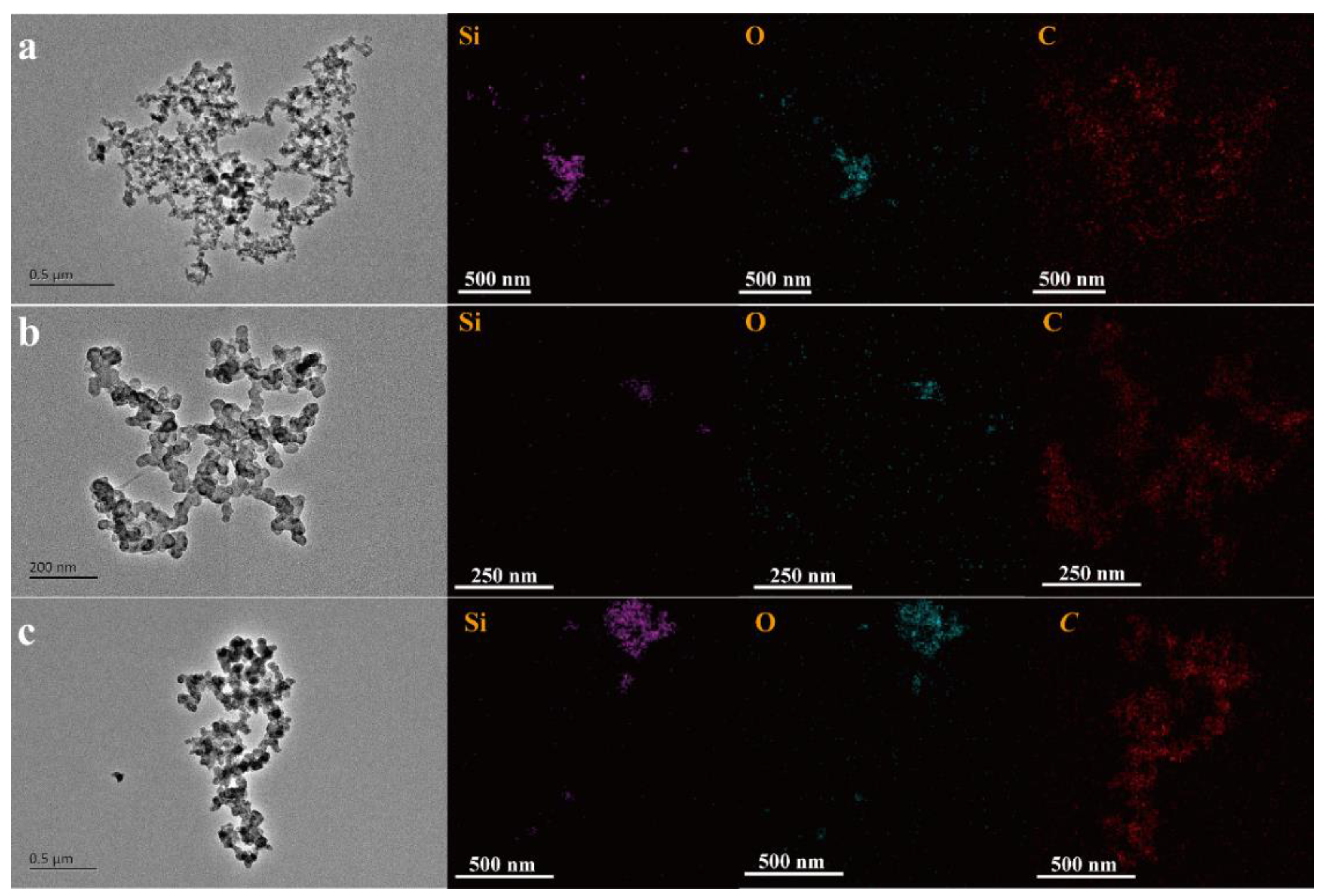
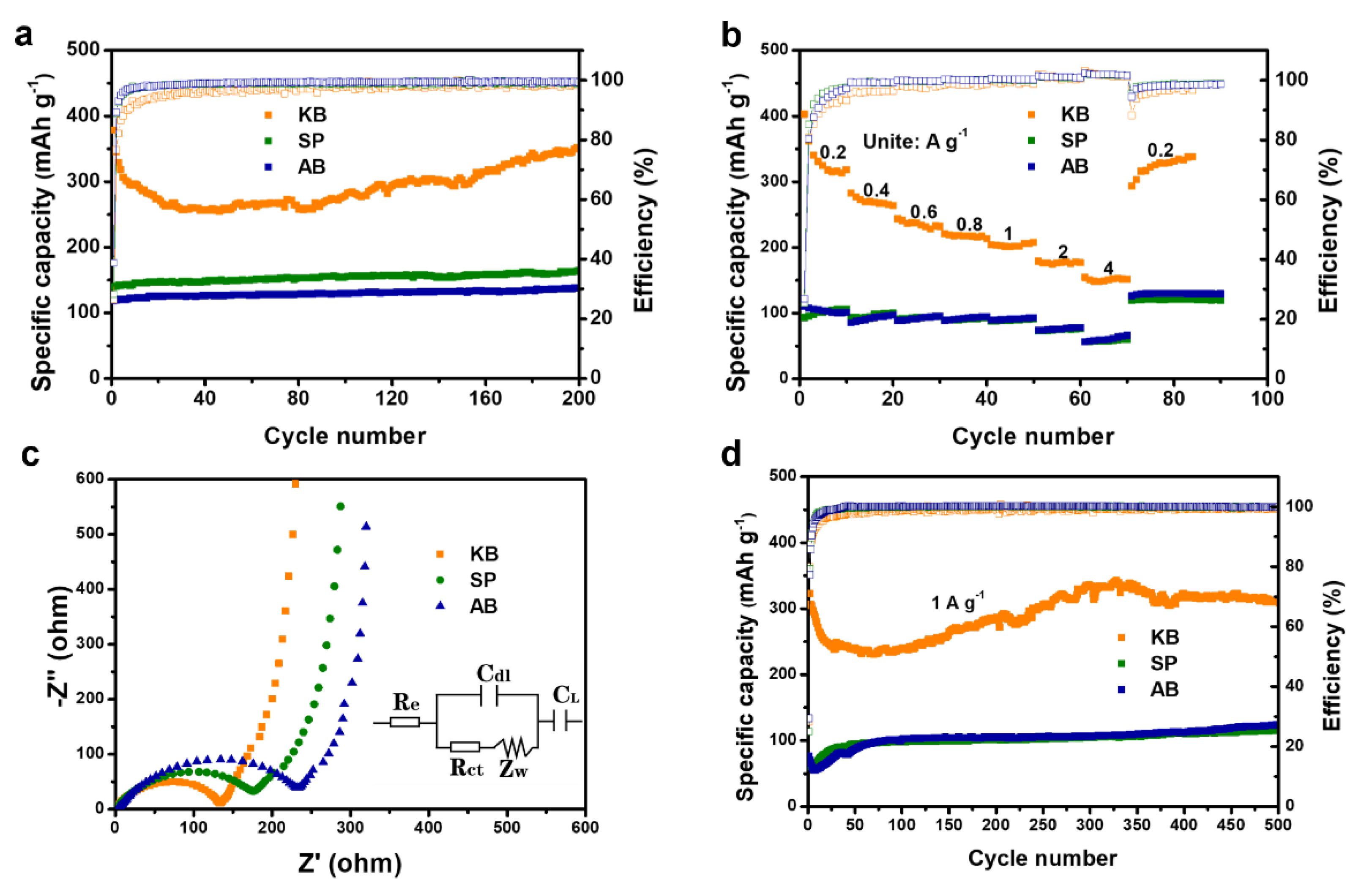
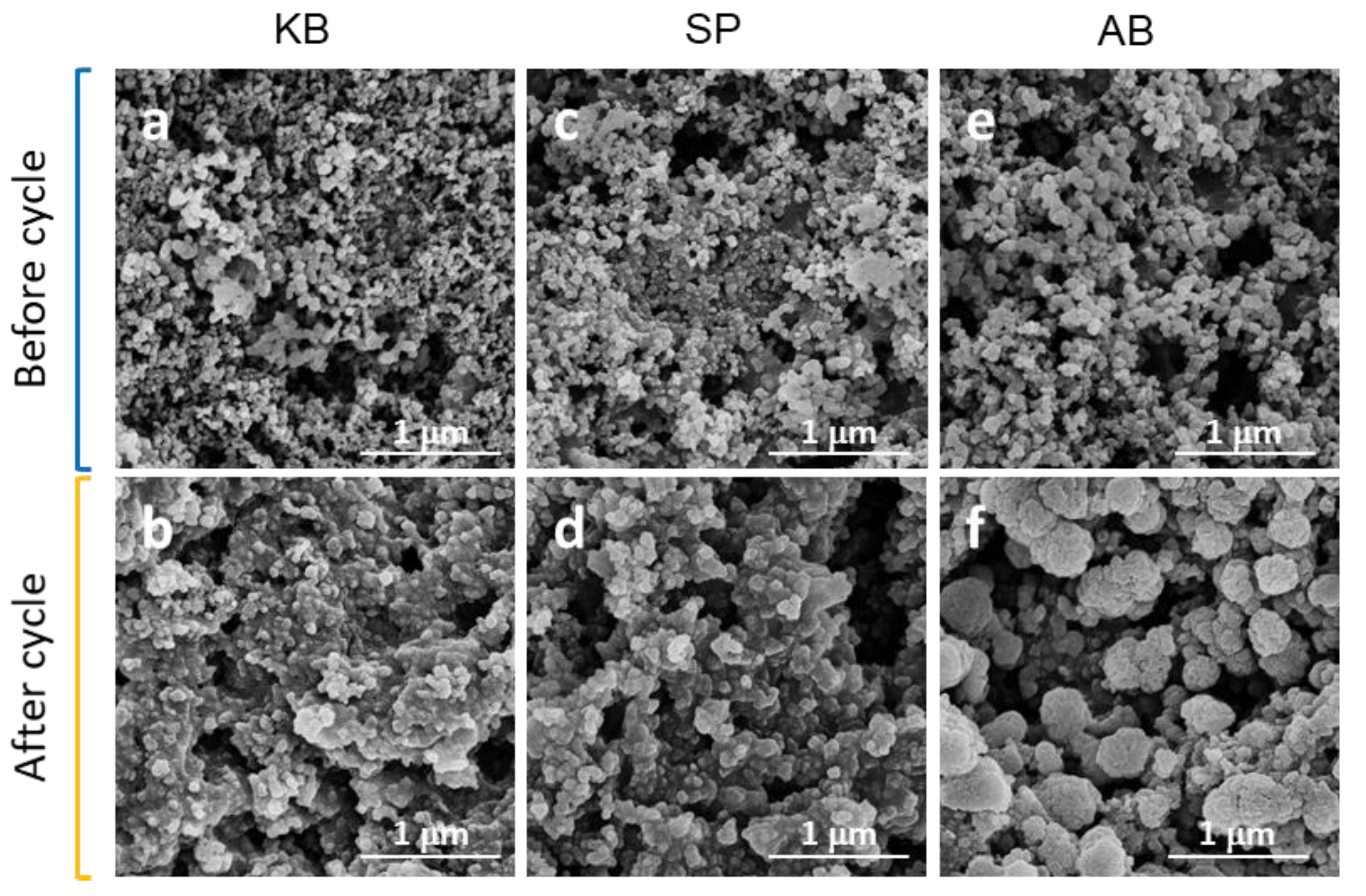


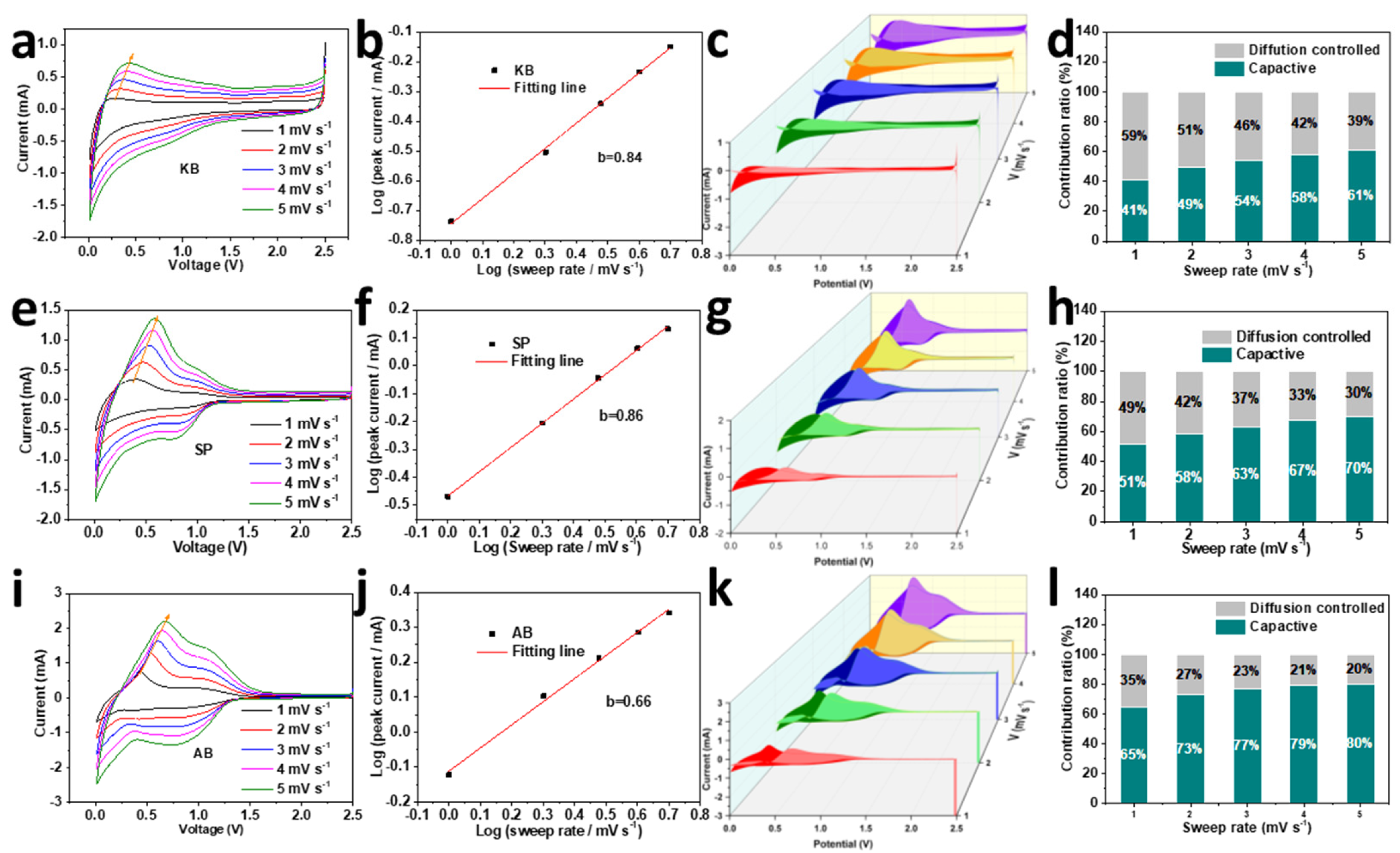
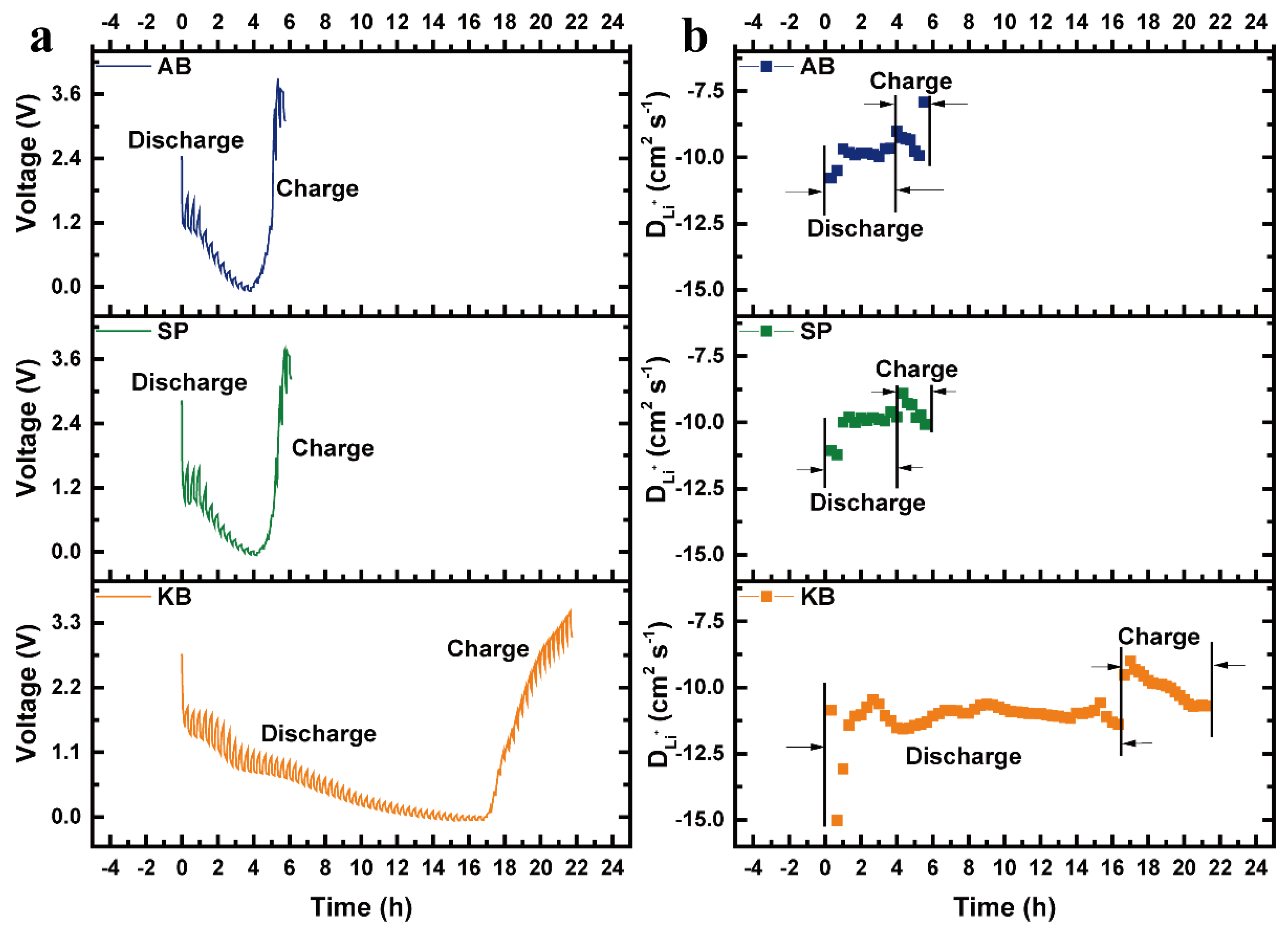


| Sample | SP | AB | KB |
|---|---|---|---|
| sheet resistance (Ω) | 125.0 | 148.2 | 64.9 |
| electrical resistivity (Ω·cm) | 12.50 | 14.82 | 6.49 |
Publisher’s Note: MDPI stays neutral with regard to jurisdictional claims in published maps and institutional affiliations. |
© 2022 by the authors. Licensee MDPI, Basel, Switzerland. This article is an open access article distributed under the terms and conditions of the Creative Commons Attribution (CC BY) license (https://creativecommons.org/licenses/by/4.0/).
Share and Cite
Hu, G.; Sun, X.; Liu, H.; Xu, Y.; Liao, L.; Guo, D.; Liu, X.; Qin, A. Improvement of Lithium Storage Performance of Silica Anode by Using Ketjen Black as Functional Conductive Agent. Nanomaterials 2022, 12, 692. https://doi.org/10.3390/nano12040692
Hu G, Sun X, Liu H, Xu Y, Liao L, Guo D, Liu X, Qin A. Improvement of Lithium Storage Performance of Silica Anode by Using Ketjen Black as Functional Conductive Agent. Nanomaterials. 2022; 12(4):692. https://doi.org/10.3390/nano12040692
Chicago/Turabian StyleHu, Guobin, Xiaohui Sun, Huigen Liu, Yaya Xu, Lei Liao, Donglei Guo, Xianming Liu, and Aimiao Qin. 2022. "Improvement of Lithium Storage Performance of Silica Anode by Using Ketjen Black as Functional Conductive Agent" Nanomaterials 12, no. 4: 692. https://doi.org/10.3390/nano12040692
APA StyleHu, G., Sun, X., Liu, H., Xu, Y., Liao, L., Guo, D., Liu, X., & Qin, A. (2022). Improvement of Lithium Storage Performance of Silica Anode by Using Ketjen Black as Functional Conductive Agent. Nanomaterials, 12(4), 692. https://doi.org/10.3390/nano12040692






